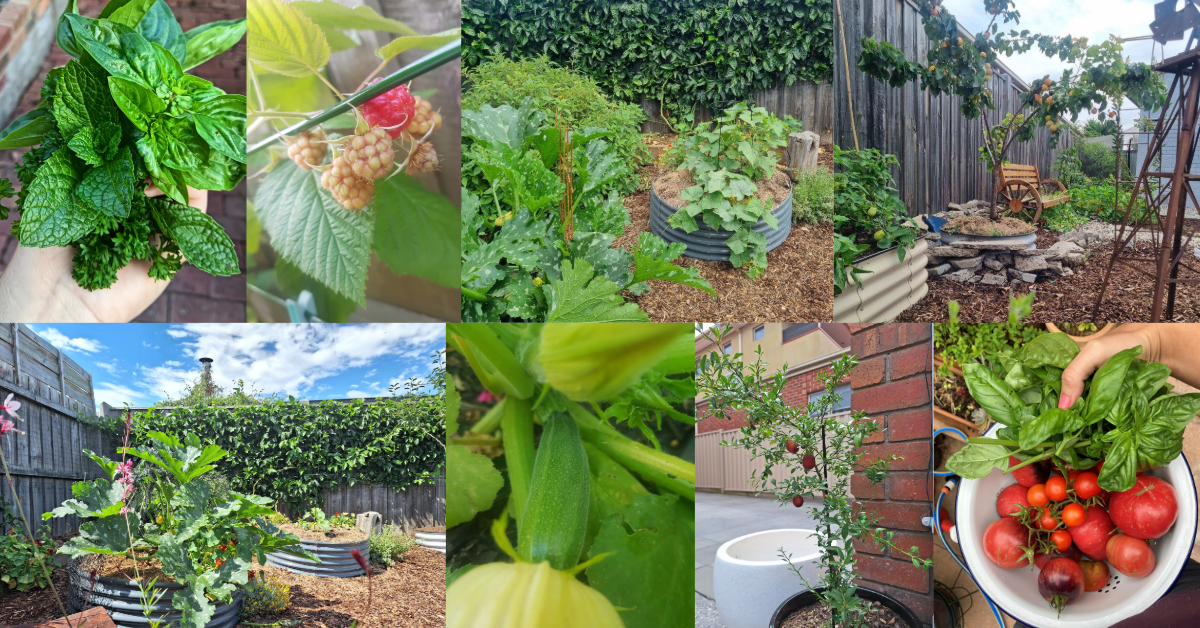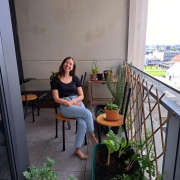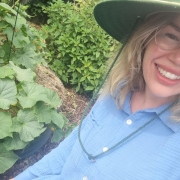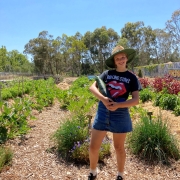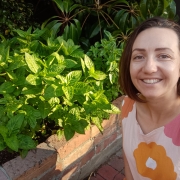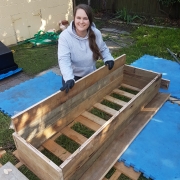The Food We Grow: Home Gardeners at Clear Horizon
January 2024
“Gardening is learning, learning, learning. That’s the fun of them. You’re always learning.” – Helen Mirren
Growing some of our own food is great for the planet, our wallets, and our physical and mental health. According to a recent study by the Australian Institute, about half of Australia’s population (52%) grows some of their own food, and another 13% are thinking about starting. Here at Clear Horizon, it’s no different, so we asked our team: what are you growing in your garden this summer?
From space-efficient balcony setups to large permaculture-principled plots, it turns out our team loves to get their hands dirty when they’re not at work. Read this article to get inspired, pick up some hard-earned advice our team wished they’d known earlier, and learn how a MEL approach can help your gardening endeavours.
Gabrielle Chamberland
Senior Consultant
Gabrielle is a senior consultant on our Sustainable Futures team. She helps clients plan for, measure and evaluate what they do, understand their impact, and improve their projects. Gabrielle is passionate about making a difference in the environmental and climate change sectors, where most of her projects sit.
I’m currently growing herbs and leafy greens on my balcony – parsley, oregano, basil, rosemary, chives, spring onions and silver beet. And a bit of lavender to keep the bugs away! I completed a food growing in urban environments a few years ago, and I have had a passion for the practice ever since. Previously, I’ve grown chilis, cucumbers and snow peas on the balcony and have also volunteered for a community garden for years, growing all sorts of foods!
If I were to give myself one piece of advice, it would be that pests like aphids and scales will come and challenge you. Balcony food growing can be tricky because very few insect predators are around. Ultimately, you’ll learn how to set up a better garden. Try different crops and find the best ones for your space.
Do you take a measurement, evaluation, and learning (MEL) approach to your gardening?
Yes, gardening is all about trying things and learning and refining as you go. Like in MEL, you set up a plan, implement it, monitor the results, see the impact, and learn what to do better next time. At the end of a growing season, you have a whole set of data on which to base your next gardening efforts.
I think the most important thing with gardening is remembering that you can’t control everything. You’re giving the plants a chance, caring for them, and seeing what happens. It’s a fun experience and a rewarding and delicious one (95% of the time!). Also, I would highly recommend wicking beds for anyone starting to garden on a balcony! They make gardening much easier.
“Anticipate the occasional visit of pests! They might challenge you, but ultimately, you’ll learn how to set up a better garden.”
Kathryn Hayes
Business Group Coordinator
Kathryn is the Business Group Coordinator working across multiple teams in Clear Horizon, providing operational support and using a background in business management to streamline processes within the organisation. Kathryn joined Clear Horizon to support the aligned values with post-graduate qualifications in Environmental Sustainability and Health Science. She is also the food-growing queen at Clear Horizon. If she’s not at work, you can likely find her in the garden, Bunnings hat on!
“My house is on a 530sm block, so it’s all about smart planting and companion planting. I’ve got a load of fruit trees like apricots, figs, mulberries, tangelos and veggies like zucchini, tomatoes, cucumbers, peppers, and broccoli. I also grow over a dozen herb varieties and a mix of native plants, shrubs, and trees. Growing up in country Victoria, I have always loved being surrounded by nature and understanding how important the surrounding environment is to us. This is the 3rd year in my home with my garden; a lot of my knowledge of growing plants and foods is self-taught or via connecting with my local community of growers/ nursery owners to learn and understand how to use my environment to produce high yields of foods and establish natives.
A piece of advice I’d love to give myself when I first started out gardening is to enjoy the learning experience – not everything will go to plan, but keep learning and going back to the drawing board to experiment to see what your garden needs and work with it rather than trying to plant a landscape based on what you find personally visually appealing instead of what your soil and area needs.
Would you say you use a measurement, evaluation, and learning (MEL) approach in your gardening?
Gardening is all about MEL! Working through each season of sowing and growing food, it is crucial to record, analyse, and understand the different approaches required for various varieties, soil types, water needs, sun exposure and more. Building on each learning experience of what worked or didn’t work enables you to reflect and adapt to grow a richer understanding of how you can work with your garden to enhance biodiversity and produce food.
“Gardening really is the best therapy!”
Mathilde Wennevold
Content Marketing Specialist
During work hours, Mathilde is busy writing and editing content to reach new and existing audiences. She loves to find fresh approaches to old problems, and when she’s not working, she loves to get her hands dirty in her garden as she gazes lovingly at her plants. Although she’s got minimal growing space available to her, she makes the most of it.
I’m currently growing tomatoes, chilis, zucchini, cucumber, eggplant, and a load of herbs and a lime tree. I think some of my plants may fight for space in a month or two, but so far, so good. I didn’t grow up in a food-growing household, but I’ve become passionate about deepening my connection with my food and where it comes from. It’s been a trial-and-error journey, but one I’ve thoroughly enjoyed. I learnt a lot while I volunteered at Melbourne Food Hub Farm, an organic market garden in Fairfield during lockdown. Following fellow food growers on social media has also been a huge help!
If I were to give my gardening newbie self some advice, it would be not to underestimate the importance of happy, living soil! Good soil really makes all the difference. Making sure it’s properly nourished, watered, and mulched is key for the health of your plants! I now compost our household scraps in an in-ground bin so that I can keep my garden bed soil healthy with nutritious compost and bokashi bin juice and reduce my food waste! I think it’s so cool that instead of becoming methane at the tip, our food scraps can nourish next season’s produce through composting.
A last bit of soil advice: If you’re growing (or planning to grow) food in the ground in inner city areas (or anywhere where chemicals may be present), consider testing your soil for lead, chemicals, and other contaminants through Macquarie University’s pro bono initiative, VegeSafe. These materials can be absorbed by your produce, especially leafy greens, and passed on to those eating them.
“Good soil makes all the difference!”
Giovanni Ferrante
Head of Marketing
Giovanni heads up the marketing team at Clear Horizon and thinks it’s the coolest job in the organisation! Apart from making Clear Horizon look good, he works to uncover the key insights of the complex stuff we do and communicate that to changemakers worldwide.
Something I’m growing this summer is a native blood lime tree, which is a cross between the Ellendale mandarin and red finger lime. It has blood-red rind, flesh, and juice. I was brought up in Italy with my grandad and father growing lots of veggies and fruit. I picked up a few tricks along the way from them, but I am most definitely not an expert. Call me an enthusiast if you wish!
Something I’d like to know when I first started out is that you shouldn’t assume that your plants will grow on their own, there’s quite a bit of work involved. Consistency is key!
Would you say you use a measurement, evaluation, and learning (MEL) approach in your gardening?
Most definitely. I set to measure the size of the limes to understand when they’re ripe. I evaluate whether I picked them at the right time by analysing the taste and juiciness. Based on those answers, I adapt how much water and sun exposure I give the tree, and when I harvest the fruit.
I think it might be harder to grow food in Melbourne than in any other part of the world because of the crazy weather and the 4 seasons in one day…it makes it more fun, though.
“Consistency is key.”
Maree Dibella
Consultant
Maree is a consultant in the Sustainable Futures team. She enjoys building insightful, interactive, and beautiful dashboards that guide change and tell stories about impact. She finds that the best way to balance computer-based work is to connect with plants, whether that’s a quick walk to the park or tending to a small garden.
I only recently moved to Naarm/Melbourne, where the climate is drastically different to North Queensland where I was prior. Within a month of moving into my sharehouse, I’ve planted thyme, basil, parsley, coriander, and spinach. After volunteering at Joe’s Market Garden, I also brought home some indigo and am excited to learn about natural dyeing techniques. And after admiring flourishing mint in a friend’s patch, I also came home with cuttings to pop in the ground.
My mum is passionate about gardening and low food miles, which means I grew up with a bounty of backyard produce. Frequent moving has meant a foray into longer-term, labour-intensive plants isn’t practical. However, growing some frequently used herbs is always simple and easy. In Townsville, I helped a friend establish the Hermit Park Veggie Patch, where I picked up a great tip to mix through some mushroom compost with the existing soil – using a cheap waste product to enrich the soil. Most of my experience with growing plants is planting natives in natural area restoration projects – another great tip is to soak the tube stock seedlings in a bucket of water prior to planting, and water again after planting. And don’t forget to mulch!
“Soak your tube stock seedlings in a bucket of water prior to planting, and water again after planting.”
Emily Graham
Senior Consultant
Emily is a Senior Consultant in the International team. She spends most of her time working with project teams to contextualise and implement fit-for-purpose, participatory and inclusive monitoring, evaluation and learning approaches and is passionate about capturing and sharing lessons to improve development effectiveness.
At the moment, I’m growing a range of fruits and vegetables, including tomatoes, zucchini, capsicums, cucumbers, raspberries and spring onions! I’ve been growing my own vegetables for a few years now, and it’s taken time to learn how to best use the space we have. Initially, I planted in different spots in the garden where we had gaps. However, these areas got varying degrees of sunlight and gave mixed results in the first year – the lettuce and carrots thrived, but I had less success with the other vegetables that year.
To increase the amount of sunlight for the plants and utilise the sides of the cemented driveway leading up to the garage, I worked with my partner (a hobby woodworker!) to build four planter boxes. Some of the plants particularly love the opportunity to grow upwards, so we added trellis-like structures to some of the boxes – which has worked particularly well for the raspberries and cucumbers! And within the past few months, we’ve implemented an automated watering system to give the plants consistency.
I continue to reflect on what works well each season, and where there are opportunities to improve. It’s important not to be too hard on yourself when things don’t work out, as there is always an opportunity to learn – and often many factors that can influence the success of our gardening adventures that are beyond our scope of control!
Do you grow food?
Whether you’re a pot of herbs in the windowsill kind of gardener, a backyard container gardener, or an entire permaculture-principled plot of land kind of home gardener, the benefits of growing some of our own food go far beyond the financial. Whether, like us, you’re part of the 52% who grow some of their own food, you’re of the 13% who’re considering starting or one of the rest who hasn’t considered it yet, we hope you found this article inspiring! Gardening is a lifelong love affair with the art of trying, succeeding, failing, learning, adapting as we go, and having another go, and another one. In many ways, it’s a great metaphor for great MEL practice! If you’re growing your own food at the moment, we’d love to hear what you’re growing, and if you have some hard-won tips and tricks for gardening success!
Sources: Australia Institute “Grow your own”: https://australiainstitute.org.au/report/grow-your-own/
“It’s important not to be too hard on yourself when things don’t work out, as there is always an opportunity to learn.”

